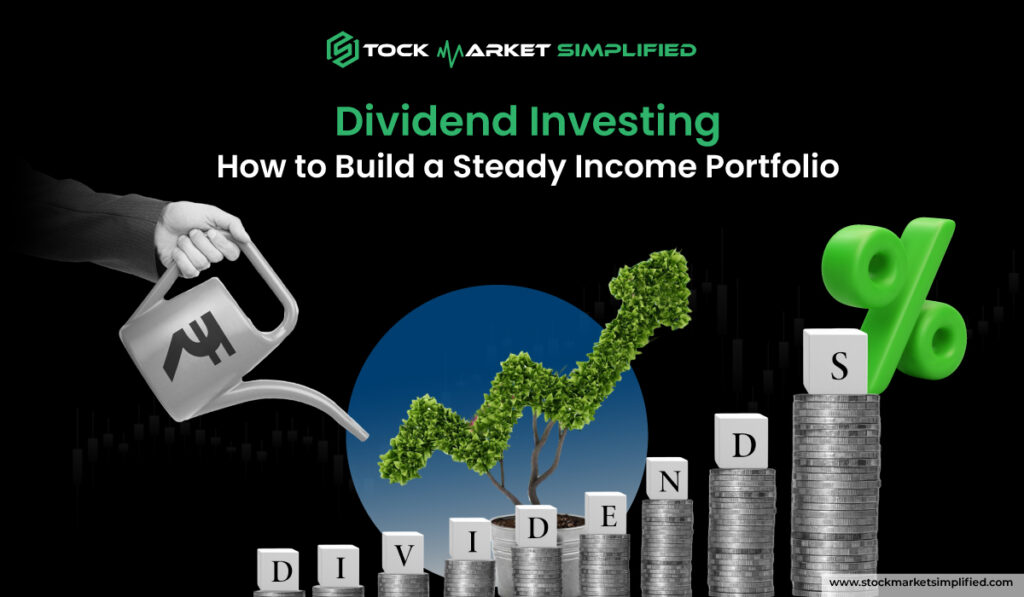Dividend Investing: How to Build a Steady Income Portfolio

Warren Buffett famously quoted, “Our favorite holding period is FOREVER.” But in today’s fast-paced world, Forever can feel like a lifetime!
When it comes to money, we all know this saying: the sooner, the sweeter.
In such cases, there’s one option in the investment world that lets traders enjoy their long-term investments while giving you the sweet taste of immediate rewards like “shagun money“— dividend investing. It’s a strategy that allows you to earn money while holding onto your investments, offering a steady stream of income without having to wait FOREVER for big returns.
However, jumping into dividend investing isn’t as simple as picking a stock and hoping for the best. There are some common do’s that new investors often need to know. This blog will equip your with fundamentals of dividend investing along with its benefits and strategies to pick the right stock. So without further fuss, let’s get in.
Also Read: How to Start Investing with Little Money: Smart Strategies for Beginners
What Is Dividend Investing?

Many beginners might not be clear on what a dividend is, so let’s simplify it: a dividend is basically a portion of a company’s profit that gets shared with its stockholders. In simpler terms, imagine it as a “thank you” from the company for holding its stock.
Usually, it’s paid out by publicly traded companies, but not every publicly traded company pay rewards to their shareholders.
So the question is: Who gets to decide it?
Well, the company’s board of directors decides if and when they’ll pay dividends, depending on how well the company is doing financially.
Dividends are typically rewards paid in cash, and you’ll usually see them come in monthly, quarterly, or yearly, based on the company’s plan. So, if you’re a shareholder, dividends are like a bonus on top of the potential rise in stock price!
Now, here is the answer of what is dividend investing:
Dividend investing is an investment strategy where investors focus on buying stocks from companies that regularly offer solid dividend payouts. The idea here is to build a reliable stream of passive income. This steady income can be a great cushion, especially when you’re thinking about long-term goals like securing a stable retirement. Plus, it complements any gains from the stock’s price increase, helping you achieve financial security.
How Dividends Are Good for Steady Income?

An equity portfolio comes with its own risks, like non-guaranteed dividends and the ups and downs of the economy. Now, instead of putting your money in a fixed deposit (FD) or a recurring deposit (RD), imagine investing in solid, dividend-paying Indian stocks that offer a 4% dividend yield. These companies should grow their dividends by at least 3% every year, which would cover inflation, and grow by 5% annually over a period of 12 years.
If this happens, let’s say a ₹5 lakh income from dividends could grow to almost ₹9 lakh per year. But, with inflation at 3%, that ₹9 lakh would actually feel like ₹6.3 lakh in today’s money. After factoring in a 10% dividend tax, that ₹6.3 lakh would drop to about ₹5.67 lakh. Still, that’s much better than the returns you’d get from an FD or RD.
While equity portfolios offer growth potential, they also come with risks like non-guaranteed dividends and market swings. To balance things out, it’s a good idea to mix both stocks and safer options like FDs or RDs in your portfolio. This strategy helps you protect against inflation and market changes. In fact, the age-old practice of putting half your money in stocks and half in safer investments works well even today.
As you get older, your priorities shift. Retirees might prefer a higher portion in FDs or RDs since they don’t need to worry as much about inflation. But if you’re younger and have 30-40 years until retirement, you’ll need to think about inflation eating into your savings if you don’t plan properly.
Building a strong portfolio doesn’t happen overnight. Unless you’re lucky enough to buy stocks at rock-bottom prices during a market crash, it could take years to find the right dividend-paying stocks. And that’s okay. Picture this: your retirement being funded by dividends from some of India’s top blue-chip companies. Now imagine owning 10, or even 30, such companies, and you’ll have a steady income to enjoy long into the future.
Identifying strong dividend-paying stocks is essential for building a reliable income-generating portfolio.
How to Identify Strong Dividend-Paying Stocks

When you’re looking to invest in dividend-paying stocks, it’s super important to choose wisely. Here are some simple steps to help you spot those companies that are likely to pay you well over time:
1. Look for a Good Dividend Yield
The dividend yield tells you how much a company pays in dividends each year compared to its stock price. A higher yield can be attractive, but be cautious—if it’s too high compared to similar companies, it might mean something is off. For instance, if a company’s stock is priced at ₹100 and it pays a dividend of ₹5, the yield is 5%.
2. Check the Dividend History
Companies with a consistent history of paying dividends are generally more reliable. Look for companies that have not only paid dividends for several years but have also increased them regularly. For example, companies like HDFC Bank and ITC have shown a strong track record of maintaining and increasing dividends over the years.
3. Examine Payout Ratio
The payout ratio is the percentage of earnings a company pays out as dividends. A lower payout ratio (around 40-60%) often indicates that the company is reinvesting enough money back into the business while still rewarding shareholders. For instance, if a company earns ₹10 per share and pays ₹4 in dividends, its payout ratio is 40%.
4. Assess Financial Health
Before investing, check the company’s overall financial health. Look for stable revenue growth, manageable debt levels, and good cash flow. A company that can generate enough cash flow can sustain its dividend payments even in tough times. For example, companies like Reliance Industries have shown strong cash flows to support their dividend payments.
5. Evaluate Business Model and Industry Stability
Consider the company’s business model and the industry it operates in. Some industries are more stable than others. For instance, utility companies like NTPC tend to offer consistent dividends because they are less affected by economic cycles. In contrast, tech companies might have more volatile earnings.
7. Diversify Your Dividend Stocks
Lastly, don’t put all your eggs in one basket. Diversifying your investments across different sectors helps spread risk. For example, you might invest in dividend-paying stocks from the banking, FMCG (Fast-Moving Consumer Goods), and pharmaceuticals sectors to balance your portfolio.
Benefits of Dividend Income

Dividend investing has several perks beside growing money with the pace of inflation:
Extra Income Stream: Dividend payments can complement your main earnings and might even surpass them over time, helping to boost your financial security and lifestyle.
Reduced Risk: Dividends offer a portion of your initial investment back, which can lower your risk. They tend to be more stable than stock prices, which can fluctuate wildly.
Indicator of Company Strength: Companies that consistently pay dividends usually have solid finances and stable demand for their products or services. This can boost investor confidence and lead to better stock prices.
Beware of Yield Traps: Protect Your Investment

Investors often fall for the high dividend yields due to the thrust of more dividend income. “But more is not always good!”
Be cautious of the yield trap. This is similar to a value trap, where high yields seem attractive at first glance. You might find companies boasting impressive current yields, but they often lack the financial health to back them up. These exciting options might lure you in, but they don’t provide the consistent income you should be after. A 10% yield might look appealing today, but it could lead you into serious trouble if the company cuts its dividend later on. So, keep your eyes open and choose wisely!
Before you start buying stocks, it’s crucial to set clear criteria for what you’re looking for. Do your research on potential companies and be patient until the price feels just right. If you’re ever in doubt, it’s perfectly fine to wait a little longer. Many investors have dodged trouble simply by saying “no” instead of rushing in. Aim to find strong blue-chip stocks with solid financials that offer dividend yields between 4% to 5% or even higher. While you can’t avoid all risks, you can definitely steer clear of unnecessary ones by being picky about your investments
Also Read: How to Spot Undervalued Stocks: A Value Investor’s Guide
Dividend Strategies for Steady Long-term Wealth

Here are some strategies to grow your wealth through dividend investing:
SIP in High-Dividend Yield Stocks:
Systematically invest in a mix of high-dividend yield stocks. This way, your dividend income can steadily increase over time.
Reinvest Your Dividends:
Use your dividend earnings to buy more shares. This can help compound your income without needing to invest more money upfront.
Mutual Funds with Dividend Options:
Consider investing in mutual funds that focus on dividend-paying stocks. Just keep in mind the tax implications on dividends.
Remember, stock prices might dip after the dividend record date, but staying invested for the long haul can lead to significant dividends that could outpace your primary income. With thoughtful planning and attention to details like dividend taxes, dividend investing can help you build a strong portfolio that generates substantial income over time.
Conclusion
Finding strong dividend-paying stocks takes time and research. By studying about the company, setting your financial preferences, and your risk tolerance, you can build a portfolio of stocks that not only provide regular income but also have the potential for growth. Remember, investing in stocks always carries risks, so it’s wise to diversify your investments to manage those risks effectively.
FAQs
What are high dividend yield stocks?
High dividend yield stocks are shares of companies that pay a higher-than-average dividend compared to other stocks in the market, often exceeding 4-5%.
What are the risks of dividend investing?
Risks include the possibility of dividend cuts, market fluctuations, and the underlying financial health of the company.
What is a dividend aristocrat?
A dividend aristocrat is a company that has consistently increased its dividend payments for at least 25 consecutive years.
Are dividends guaranteed?
No, dividends are not guaranteed. Companies can choose to cut or suspend dividends if they face financial difficulties.
What is the difference between a cash dividend and a stock dividend?
A cash dividend is a cash payment made to shareholders, while a stock dividend is paid in the form of additional shares of stock.
Can I use mutual funds or ETFs for dividend investing?
Yes, there are mutual funds and exchange-traded funds (ETFs) that focus on dividend-paying stocks, allowing for easier diversification.

 Instagram
Instagram 





